
Related
Guests
- Greg Grandinteaches Latin American history at New York University. His book Fordlandia was a finalist for the Pulitzer Prize in history. He is the author of Empire’s Workshop: Latin America, the United States, and the Rise of the New Imperialism. His most recent work is titled The Empire of Necessity: Slavery, Freedom, and Deception in the New World.
In his new book, “The Empire of Necessity: Slavery, Freedom, and Deception in the New World,” acclaimed historian Greg Grandin examines how the transnational slave trade transformed the world, causing mass economic, social and political upheaval in ways that continue to reverberate today. Grandin tells the true story of a slave insurrection aboard a ship named the Tryal in 1805, in which West African men and women rose up and seized the vessel. The uprising inspired Herman Melville to write his novella “Benito Cereno” that drew on the memoirs of Captain Delano, a distant relative of President Franklin Delano Roosevelt. Today, Grandin has used the dramatic incident to show how slavery was the “flywheel” that drove the global development of everything from trade and insurance to technology, religion and medicine for nearly four centuries. A professor of Latin American history at New York University, Grandin’s last book, “Fordlandia,” was a finalist for the Pulitzer Prize in history.
Transcript
JUAN GONZÁLEZ: We’re going to spend the rest of the hour discussing a remarkable new book that shows how the transnational slave trade transformed the world, causing mass economic, social and political upheaval in ways that continue to reverberate today. The book is written by the acclaimed historian Greg Grandin, and it’s called The Empire of Necessity: Slavery, Freedom, and Deception in the New World. It tells the true story of a slave insurrection aboard a ship named the Tryal in 1805 in which West African men and women rose up and seized the vessel.
AMY GOODMAN: The uprising inspired Herman Melville to write his novella Benito Cereno, that drew on the memoirs of Captain Delano, a distant relative of President Franklin Delano Roosevelt. In his new book, Greg Grandin has used the dramatic incident to show how slavery was the flywheel that drove the global development of everything from trade and insurance to technology, religion and medicine for nearly 400 years.
Well, for more, we go right to Greg Grandin. He teaches Latin American history at New York University. His book Fordlandia was a finalist for the Pulitzer Prize in history. He’s also the author of Empire’s Workshop: Latin America, the United States, and the Rise of the New Imperialism.
Greg Grandin, welcome to Democracy Now! So tell us this story.
GREG GRANDIN: Well, the book begins with this story of Amasa Delano, who was a distant relative of Franklin Delano Roosevelt, from a less successful branch of the Delano family, Duxbury, Massachusetts. And he was in the South Pacific. He was hunting seals. And he came upon a distressed Spanish slave ship that was in trouble. The sails were tattered. It was pulling a long trail of garland of seagrass. It was in bad shape. And he boarded the ship.
And events conspired that he was alone on the ship with who he thought was the captain, Benito Cereno, and about 70 West African men and women and only a handful of Spanish sailors. And he spent all day alone on board, observing the ship, thinking it was in distress, but a normally functioning slave ship. He was told that the ship had run into a storm, and then fevers hit, and that’s why there weren’t many Spaniards around. And through it all, he kept on noticing the strange relationship between the Spanish captain and a West African who was introduced as Cereno’s body servant, personal slave, who wouldn’t leave the two captains alone to talk, even though Amasa Delano kept asking, “Can we step aside to talk?” And he tended to him faithfully. He wiped spittle from his mouth, as he was in a bad state, the Spanish captain of the ship.
And Amasa Delano, who was an experienced mariner—this was the third trip around the world—couldn’t see that the West Africans were in charge, that they—that over 50 days earlier, they had risen up, seized the ship, killed most of the Spaniards, including the slaver, who was taking them to Lima, Peru—remember, this is in the South Pacific, not the Atlantic, the other side of the Americas—and sailed, and demanded to be returned to West Africa. And Benito Cereno, the Spanish captain, stalled, sailed up and down, trying to buy time, not wanting to round the cape and into the Atlantic. And that’s when they came across Amasa Delano’s ship.
Now, the West Africans had two choices: They could have fought, or they could have fled. But instead, they came up with this remarkable plan. They were starving, and they were dehydrated and thirsty. Two women and two children died. And yet they managed to stage this nine-hour pantomime of the master-slave relation and trick this New England mariner, who understood himself as a reformer, forward-looking, a man of the world, who had a realistic vision of how things worked. It was just a remarkable story.
JUAN GONZÁLEZ: And how did you first come across the story? And you traveled all around the world, basically, to research archives to find out the details of what had happened here.
GREG GRANDIN: Yeah. Well, I found the—I mean, I assigned Herman Melville, as Amy mentioned—50 years after the event, Herman Melville reads about the story in Amasa Delano’s memoir, chapter 18 of his memoir, and turns it into this haunting novel, or novella, published in 1855, which we could talk about later. And so, I assigned that in a class on U.S.-Latin American relations, not because I thought it was true, but because I thought it was a nice, novelistic illustration of U.S.-Latin American relations during the time of slavery. And I read—it wasn’t a secret. Literary scholars knew that it was based on a true story. And I started doing more and more research into it, and it just opened up into this incredible, incredible history.
AMY GOODMAN: Talk about the links between slavery and capitalism, and the phrase the Spanish used, the “free trade in blacks.”
GREG GRANDIN: Yeah. Well, when we think of slavery in the United States, we think of its explosion after the cotton gin, after the move into the West, after the War of 1812, something that happened in the 19th century. New World—slavery obviously existed since Columbus landed in the Americas, in the New World, but it really was in the 1770s, first in the Caribbean, then in Brazil, Portuguese Brazil, and then in Spanish America, that European powers—Spain and Portugal—begin to deregulate the tight mercantile restrictions that had governed slavery for centuries, basically unleashing, privatizing, deregulating. Spaniards were kind of frank in the phrase: They called it the “free trade in blacks.”
And this kicks off this remarkable market revolution that revolutionizes the New World, in which what happens—what happens in the United States after 1812 is the last phase of, in some ways. Remember, Amasa Delano is leaving New England in 1803. Slavery is on its way out in New England. A lot of people thought it was on its way out in the South. And what he sails into in the South Pacific in some way was a preview of the race terror and violence and ecological destruction associated with slavery that would grip the United States decades later. He was sailing, in some ways, into the future.
JUAN GONZÁLEZ: And one of the things you talk about, in terms of the slaves who engaged in this insurrection, was that many of them were Muslims.
GREG GRANDIN: Yeah.
JUAN GONZÁLEZ: And you go at great length to discuss the Muslim influence on the African slaves here and its impact on the development of—not only of Spain, but also of the Americas.
GREG GRANDIN: Yeah. I mean, historians have—historians estimate—some historians estimate that as many as 10 percent of all the West Africans—of all Africans brought into the Americas were Muslim, those who came primarily from West Africa, starting in the early 1500s through the end, through the 19th century. These West Africans were—they were brought out of different places in West Africa and into Montevideo, across the Atlantic, and then marched across the whole of the Americas, the Pampas and over the Andes, and they tracked their movements by following the Islamic lunar calendar. And they rose up on the holiest day of Ramadan, the Night of Power.
So there’s a way in which Islam—I mean, you know, one of the things that I try to make the case for, implicitly in the book and explicitly in this essay that I wrote in The Nation, was that this notion of a clash of civilizations between the Islamic world and the Western world, a fault line, and Samuel Huntington’s famous phrase, is just nonsense when you think about the history of slavery, that Muslims and Islam were present in America from the beginning, through the—often covertly so, through the institution of slavery.
AMY GOODMAN: Also, this critical time, 1803, 1804, this is also the time of the first slave uprising that leads to the establishment of a new nation, Haiti.
GREG GRANDIN: Yeah, Haiti. Haiti, in 1804, declares itself independent. And actually, one of the—so, this really—the story happens a generation after the American Revolution, a generation before Spanish-American wars of independence, and the year Haiti, the first and only slave revolt that leads to the creation of a republic, the second republic in the Americas, take place. The West Africans actually ask to be taken, after they rise up and seize the ship, to a land of blacks that they exist—that they heard exist in these waters. Benito Cereno, the captain, says no such land exists—I mean, immediate denial of the reality of Haiti. I mean, he certainly didn’t want to sail the ship to Haiti. And so, it was after that that the West Africans demanded to be returned to Senegal.
AMY GOODMAN: Who was Amasa Delano named after?
GREG GRANDIN: Amasa Delano was named after his uncle, who was a militia member during the Seven Year War with the British forces. And he was involved in—this is a little side tangent in the story—he was involved in a massacre of Native Americans up the Connecticut Valley near Canada. And in fleeing from retribution from the community, they got lost in the winter coming down the Connecticut Valley, and they wound up—they wound up killing the Native American prisoners of war that they had and cannibalizing them. So, there’s something—I mean, you know, all of Amasa Delano’s other siblings were named William and Alexander and all of these other, you know, innocuous names. For some reason, his parents named him after his uncle, who wasn’t—kind of portended something not—
JUAN GONZÁLEZ: Well, you know, over the last 30, 40 years, we’ve had an enormous amount of scholarship on the African slave trade and links to economic development here, obviously, in the New World. What did you—using this one insurrection on one ship as a prism to look at the entire system, what were some of the new insights that you think the reader will take away from your book that hasn’t been really mined by previous scholars?
GREG GRANDIN: Well, a lot is obviously based on the work of scholars that went before, and mine is a very close study. It’s this narrative history, and it follows these two tracks. One is the history of the West Africans out of West Africa into Buenos Aires and Montevideo and then across the Americas, and then the other follows Amasa Delano coming into the Pacific as a seal hunter, and the intersection of those two stories and those two narrative lines. I think it provides the fullness of slavery. It gives a sense of not just the Middle Passage across the Atlantic and the horrors of the Middle Passage, which we know of, but a second Middle Passage across the American continent and over the Andes, the highest point in the Americas, and then down into the Pacific. It was an incredible ordeal of these West Africans. So it gives the fullness of that. It gives the fullness of slavery’s importance in, as I mentioned earlier, this market revolution. 1804—1803, 1804, when the West Africans were brought into Buenos Aires, more slaves were brought into Buenos Aires and Montevideo that year than in any previous year. It was just this free-for-all, this free trade in blacks, this unleashing of this market revolution.
JUAN GONZÁLEZ: Likewise in Cuba, the huge—
GREG GRANDIN: Yeah.
JUAN GONZÁLEZ: —the huge trade and importation of slaves—
GREG GRANDIN: Really takes off, around this time, yeah.
JUAN GONZÁLEZ: —takes off the 19th century.
GREG GRANDIN: Yeah, yeah, around this time. And then, I think it gives a sense not just of the geographic dimensions, from the Atlantic and across the Americas and the Pacific, but the fact, as I mentioned, that Amasa Delano—it gives it almost a chronological sense. So, Amasa Delano was caught up in this race terror and his own involvement in putting down the rebellion once he finds out the reality of the situation. But then, 50 years later, when Herman Melville reads about the story, what Amasa Delano sales into in the Pacific has come full bore into the United States. So it gives a sense of the chronological sweep of this market revolution.
AMY GOODMAN: Compare Amasa Delano and Samuel Delano, and talk about who they are.
GREG GRANDIN: Well, Samuel Delano was his brother, Amasa Delano’s brother. And Samuel Delano was also involved in this. He actually wasn’t there for the deception and its repression. He was off sealing on his own ship. They had come down together. But he was involved in other—other incidents of race violence outside of the borders. And what’s interesting is that they’re both failures in different ways, right? I mean, they’re involved during the boom of sealing, taking out hundreds of thousands of seal skins and selling them in China, making an enormous amount of money in the 1790s, but then the bust of sealing, which is dramatic, in the early 1800s, when this incident happens.
And they both represent, I think—when they come back to the United States, you know, Amasa Delano was a Republican—and Republican in the sense of the word back then. He was pluralist. He had almost a generous, tolerant understanding of other cultures. That devolves into a kind of jaundiced skepticism about America, about Christianity, about the whole operation. He becomes much more pessimistic. Samuel Delano becomes much more of a fundamentalist. He becomes—when he comes back to the United States, and he’s as much a failure as Amasa Delano is, he doubles down on Christianity. He jettisons the liberal Christianity of his Massachusetts youth, which had moved away from that Calvinist gloom, and embraces a kind of fire-and-brimstone Christianity. So, in some ways, I think they encapsulate—if you think of the New Right and the New Left coming out of Vietnam, right? The New Left is skeptical, anti-imperialist. You know, that’s in its political form, but just, you know, cynical, in general. And then the New Right becomes more certain about American power. In some ways, I think they prefigure the two polls of what happens when the U.S.—when people involve themselves or participate in racial terror outside the U.S. borders. They come—
JUAN GONZÁLEZ: One of the interesting things—I think it was in a separate piece that you wrote where you were trying to make not only a literary analysis, but also bringing in modern politics, when you were talking about the difference between Melville’s two books, not only his book on this incident, but also Moby-Dick, and the difference between whaling—
GREG GRANDIN: And sealing.
JUAN GONZÁLEZ: —and sealing. Could you talk about that?
GREG GRANDIN: Yeah. You know, Ahab, Melville’s most famous character, is an emblem, a symbol of—he has been used as an emblem or symbol of unhinged American power—egotistical, hubristic, ambitious, damning God in the heavens, driving everybody around him to ruination. He is held up almost as a precursor to modern totalitarianism, in which he’s able to pull his men into his power and will through charisma, through emotional attachment.
I think Amasa Delano represents a more modern form of power, the control of labor in a moment of diminishing natural resources. Amasa Delano is basically in the middle of this bust. There’s no seals to kill, no money to be made. His men are grousing and complaining and conspiring against him. He’s resorting to more—more physical punishment in order to maintain his authority, until they come upon this ship. And so, when Ahab rallies his men in pursuit of a metaphysical white whale, Amasa rallies his men in pursuit of black rebels, real black rebels. And in doing so, in putting down the rebellion, he reaffirms his authority. So I think it’s much more of a social or political economic analysis of U.S. power that Amasa Delano represents.
AMY GOODMAN: And tell us about Babo, the leader of the Africans on the ship.
GREG GRANDIN: Well, Babo was an older man, an older West African, and him and his son Mori are often credited as the organizers. And it was Mori, in the real events, that pretends to be Benito Cereno’s body servant, right, the faithful, humble, loyal body servant. Melville kind of combines the two characters. Maybe he just thought the name Babo was more evocative of something. And in the story, it’s Babo who is the loyal servant. And it’s a remarkable portrayal and rendition of this character, who—it’s not 'til the—Melville tells this whole story through the perspective of Amasa Delano. We don't know that the slaves are in charge and Babo isn’t a loyal servant until the end of the story, until Melville reveals it to be so. And I think it—I think Melville is really capturing a lot of the—a lot of racial tropes that are developing in the 1850s.
If you compare Benito Cereno to a more popular and well-known story, Harriet Beecher Stowe’s Uncle Tom’s Cabin, Harriet Beecher Stowe makes a case for abolition by presenting Africans as transparent and innocent, Christlike. You know, they have—there’s no distinction between what’s on the outside and what’s on the inside. They’re pure, and we can support them. And we can—and that’s why she’s making the case for emancipation. Melville portrays his West Africans as cunning. They’re hiding what they really are. And then they’re historical figures that are willing to use—to visit the violence and barbarism perpetuated on them with equal violence and barbarism. So it’s a fascinating portrayal.
AMY GOODMAN: We’re talking to Greg Grandin. He teaches Latin American history at New York University. His new book is The Empire of Necessity: Slavery, Freedom, and Deception in the New World. This is Democracy Now! We’ll be back with him in a moment.

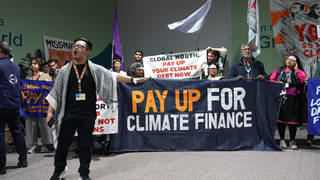
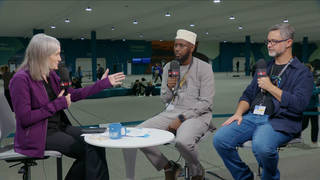
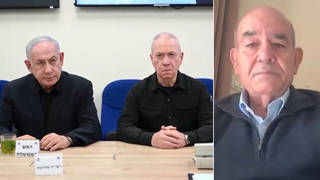
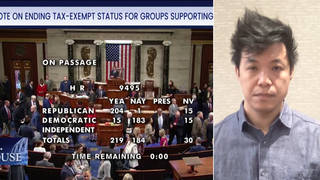






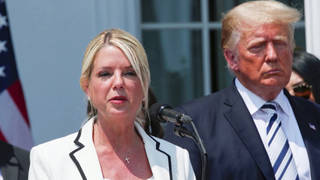
Media Options